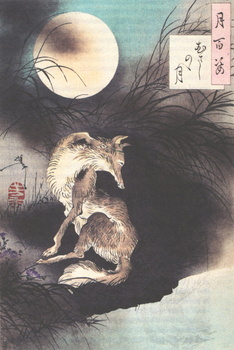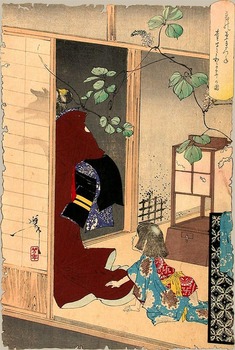Iíve been reviewing a lot of images of Japanese woodblock prints (ukiyo-e) to use in the redesign of Yoshi & Tsukiís web site. In the process, I found this amazing artist named Tsukioka Yoshitoshi (1839-1892)(check it out, TSUKIoka YOSHItoshi!). His name is just sort of an odd coincidence, but his art is very unlike that of his contemporaries. At times, his works almost border on surrealism. I would encourage anyone with an interest in Japanese art to have a look at his works that are available at Wikimedia Commons.
Though not particularly surreal, these are the prints that have received Yoshi & Tsukiís seal of approval:
The Moon on Musashi Plain (Mushashino no tsuki)
From the series: One Hundred Aspects of the Moon (Tsuki hyakushi)
April 1, 1892
The four final prints of the One Hundred Aspects of the Moon were published in April 1892, but all of them had been designed and printed earlier. This picture of a vain vixen admiring herself in a pool was printed at the beginning of 1891, more than a year before it was issued. Foxes were thought to take human shapes, and Yoshitoshi had designed an earlier picture in the Moon series of a transformed fox returning to his own form (see The Fox Cry below). The foxís preening gesture in this print still seems quite human. The shadows in the print were hand-painted on the woodblock, and their pattern and intensity varies from impression to impression.
Source of descriptive information: Keyes, R. & Kuwayama, G. (1980). The Bizarre Imagery of Yoshitoshi: The Herbert R. Cole Collection. Museum Associates of the Los Angeles County Museum of Art. Los Angeles: California.
The Fox Cry (Konkai)
From the series: One Hundred Aspects of the Moon (Tsuki hyakushi)
January 1886
Konkai, meaning the cry of a fox, is the title of a kyogen, a comic interlude performed between Noh plays. In the story, an old fox, tired of being hunted, disguises himself as an old priest named Hakuzosu, known for his fondness for foxes. The fox visits the priestís nephew, a hunter in the region, and speaks to him about the virtues of foxes and the punishments that await those who take life. He leaves satisfied that he has convinced the man. On the way home he begins to change back into a fox and thus loses the capacities of foresight and reason. A baited trap looks suddenly attractive, and he takes the bait and is caught. Yoshitoshi shows the stooped and elderly priest walking home by moonlight and beginning to change back into a fox.
Source of descriptive information: Keyes, R. & Kuwayama, G. (1980). The Bizarre Imagery of Yoshitoshi: The Herbert R. Cole Collection. Museum Associates of the Los Angeles County Museum of Art. Los Angeles: California.
The Fox Woman Kuzunoha Leaving Her Child (Kuzunoha-gitsune doji ni wakarumu no zu)
From the series: New Forms of Thirty-Six Ghosts (Shinkei sanjurokkaisen)
1890
The young nobleman, Abe no Yasuna, on his way to visit a shrine in Shinoda, in Settsu Province, encounters a young military commissioner who is hunting foxes in order to obtain their livers for use as medicine. Yasuna battles the hunter, sustaining several wounds in the process, and sets free the white fox he had trapped. Afterward, a beautiful woman named Kuzunoha comes along and helps him return to his home.
In reality, this woman is the fox he had saved, adopting human form in order to tend to his wounds. He falls in love with her, and they marry. Later, she bears him a child, Seimei, who proves prodigiously clever. Kuzunoha realizes that her son has inherited part of her supernatural nature.
Several years later, while Kuzunoha is viewing the chrysanthemums, her son catches sight of the tip of her tail. Her true nature revealed, Kuzunoha prepares to depart to return to her life in the wild. She leaves behind a farewell poem, asking her husband, Yasuna, to come to see her in Shinoda forest.
Yasuna and his son search Shinoda for Kuzunoha, and eventually she appears to them as a fox. Revealing that she is the kami, or deific spirit of Shinoda shrine, she gives her son, Seimei, the power to comprehend the language of beasts.
Source of descriptive information: Wikipedia




Unbelieveable! This is incredibly cool! Not only the name coincidences, but the fox imagry, etc. I am very pleased that you included some history and explanation to the work... Looking forward to the new website update--- any idea of when? We are going to try to get it together for our own Shiba dogblog!
Wow this is so wonderful & educational.
I love this artist.
Actually some Shiba owners try to dig Japanese culture.
I found many interesting names on some Shiba meet up groups' sites.
Some of them named their Shibas "Kitsune" which means Fox in Japanese.
But the one really flipped me was "Inari" which is one of the Shinto Gods.
And Fox are Inari's loyal servants.
Well, I guess Shiba oweners realize they have to be intelligent because their dogs are.
BTW
I found the blog of Japanese pottery artist you mentioned be4 Christmas.
She is an avarage Japanese house wife whose kids have grown up and felt kinda empty about her life.
Then she discovered joy of making pottery and got a shiba named Gaku.
Those two brought her so much happiness that she combined two as Shiba pottery.
It is a Japanese blog but you can enjoy the pics.
mari2.blog01.linkclub.jp/